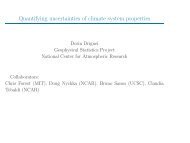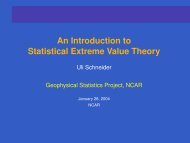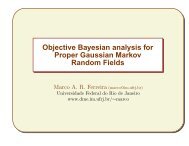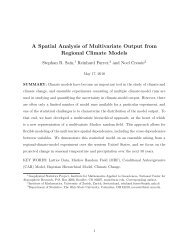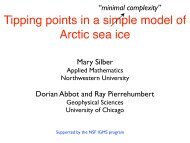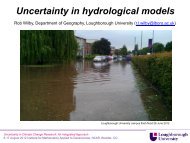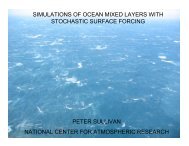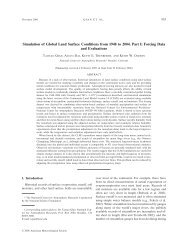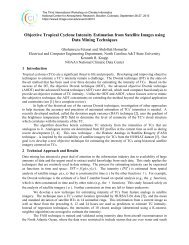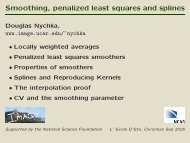David Karoly, Frank Drost and Ailie Gallant University of ... - IMAGe
David Karoly, Frank Drost and Ailie Gallant University of ... - IMAGe
David Karoly, Frank Drost and Ailie Gallant University of ... - IMAGe
Create successful ePaper yourself
Turn your PDF publications into a flip-book with our unique Google optimized e-Paper software.
<strong>David</strong> <strong>Karoly</strong>, <strong>Frank</strong> <strong>Drost</strong> <strong>and</strong> <strong>Ailie</strong> <strong>Gallant</strong><strong>University</strong> <strong>of</strong> Melbourne, AustraliaUpdate <strong>of</strong> <strong>Karoly</strong> <strong>and</strong> Braganza, 2001; Braganza et al., 2003, 04Climate extremes index - <strong>Gallant</strong> <strong>and</strong> <strong>Karoly</strong>, JClim, 2010
<strong>Karoly</strong> & Braganza simple indices• Would like a small number <strong>of</strong> indices <strong>of</strong> globalsurface temperature variations that representdifferent aspects <strong>of</strong> natural climate variability butrepresent key features <strong>of</strong> patterns <strong>of</strong> anthropogenicclimate change• Want indices that show a common signal due togreenhouse climate change but are nearlyindependent for natural climate variations– Global mean surface temperature (GM)– Mean l<strong>and</strong> – ocean temp difference (LO)– Mean NH -– SH temp difference (NS)– Mean magnitude <strong>of</strong> the annual cycle over l<strong>and</strong> (AC)– Mean meridional temperature gradient in the NH (MTG)
Data• Gridded instrumental observations for surface airtemperature <strong>and</strong> SST for 1881-2009 fromHadCRUT3 (Met Off, UK), GHCN-ERSST (NOAA,US), <strong>and</strong> GISS Temp (NASA, US)• Coupled ocean-atmosphere climate modelsimulations, 8 different models– unforced simulations <strong>of</strong> internal climate variability (longcontrol runs, typically 500 years)– multi-member ensembles <strong>of</strong> simulations <strong>of</strong> the 20 thcentury, including variations in anthropogenic forcings(greenhouse gases <strong>and</strong> aerosols) <strong>and</strong> natural forcings(volcanic aerosols <strong>and</strong> solar irradiance changes), 30runs
Common responseSimple indices from CMIP3model simulations for C20C<strong>and</strong> A1B emissions.Dark grey shading is ±1σabout ensemble mean
Climate variability• Compare internal variabilityin control simulations withdetrended observations• Interannual <strong>and</strong> decadalvariations• Some models (1,5, 8) havetoo small variability inseveral indices• Decadal variability <strong>of</strong> MTG istoo large in several models
Correlations <strong>of</strong> decadal variations <strong>of</strong> indices fromdetrended obs <strong>and</strong> 120 yr segments from control runs
Climate change• Trends over 1960-2009• Grey b<strong>and</strong> is 90% confidinterval from control runs• Significant trends in all obsindices, except NS• General agreement <strong>of</strong> obs<strong>and</strong> model trends except formodel 5• Generally too small forcedresponse in models for AC
RLO, ratio <strong>of</strong> warming on l<strong>and</strong> to ocean• RLO = Δ(l<strong>and</strong> T relative to 1900-30 av) / Δ SST• Upper panel for obs, note smaller values for El Nino• Smaller ocean warming due to heat capacity <strong>and</strong>evaporationRLO av for 1990-2009HadCRUT3 = 1.3GISS = 2.0NOAA = 1.7Models = 1.5
Climate Extremes Index, CEI• Karl et al., 1996, Gleason et al, 2008 http://www.ncdc.noaa.gov/extremes/cei/• Fraction <strong>of</strong> area <strong>of</strong> country experiencing muchabove/below normal:– Mean maximum temperature– Mean minimum temperature– Soil moisture– Proportion <strong>of</strong> rain from very heavy rain days,– Number <strong>of</strong> rain days• Multivariate, non-parametric• Current use adds contribution from extremes below10th %ile <strong>and</strong> above 90th %ile, which is a problem ifthere is a trend
Mean Tmax > 90%ileHeavy 1-day precipMean Tmax < 10%ileMean Tmax, combinedFromNOAACEIwebsiteCEI, 5 comps
Data from NOAA CEI websiteComponent 1 Extreme mean max temperatureComponent 3 Extreme mean moisture (PDSI)Percentage area30%90th %ileCombined10%0%1910 1930 1950 1970 1990 2010-10%-20%-30%Percentage area20%15%10%5%0%1910 1930 1950 1970 1990 2010-5%-10%-15%90th %ileCombined-25%Component 2 Extreme mean min temperatureComponent 5 Extreme number rain daysPercentage area40%90th %ileCombined20%10%0%1910 1930 1950 1970 1990 2010-10%-20%-30%Mean Tmax < 10%ilePercentage area20%15%10%5%0%1910 1930 1950 1970 1990 2010-5%-10%-15%90th %ileCombined-25%



